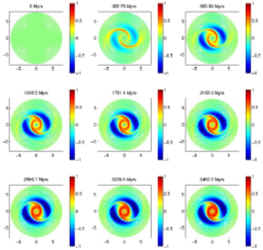|
Home \ History \ CFD-MHD Project Research Highlights
CFD-MHD Project Research Highlights
The structure and evolution of gas disks in galaxies

Numerical simulations of NGC5248. The sequence from left to right and top to bottom shows the evolution of the gas disk of NGC5248 under the influence of a major bar in the system. (with David C.C. Yen)
Chi Yuan and his research group focused on the structure and evolution of the inner gas-dust disk of nearby spiral galaxies in 2002. They extended the non-linear asymptotic theory developed earlier by their group and successfully demonstrated that the observed spiral structure and its kinematics of NGC5248 can be explained by the theory (Yang 2002). Furthermore they showed that the rigid-body rotation near the center forms an exceedingly firm evanescence region which waves cannot penetrate and hence makes it difficult to fuel AGN and starburst ring activities in the center. However, slightly deviating from rigid-body rotation would allow waves to go to the center (Yuan, Lin and Chen 2002; Yuan and Chen 2002; Chen 2002). Along the theoretical development, Yuan wrote a review article of the subject published in Space Science Review (Yuan 2002). For the evolution of the central gas-dust disks, the group has developed high-performance gas-dynamic codes, in particular for solving bar-driven density waves in galactic disks (see description in the CFD section). The codes are written in both the relaxation method and the high-order Godunov method. For the stellar dynamics of disk galaxies, Yuan's collaboration with Uri Griv still continues (Griv, Gadelin and Yuan 2002a and 2002b).

Fig. 1 is a high-resolution velocity field of the central region (30¡¨X30¡¨) of the galaxy NGC 4945 observed by S. Muller using SMA. In the central 20¡¨X20¡¨ region, the isovelocity contours show several sets of curved lines, which indicate the locations of spiral density waves. Fig. 2 and Fig. 3 show respectively the isovelocity contours and the projected density distribution of the simulation result. Superimposition of Fig. 2 onto Fig. 1 is shown in Fig. 4. The S-shaped feature around the galactic center in the observation is closely reproduced by the simulation. The result of superimposing the density distribution (Fig. 3) onto the observed velocity field (Fig. 1) is shown in Fig. 5. We can see clearly that the velocity contours bend outwards along the spiral arms in this figure, which is one of the distinct features for density waves excited at the ILR. Across the spirals, matter collides with the arm from the concave (or inner) side and is deflected by the shock, resulting in mass inflow to fuel the AGN.
|




